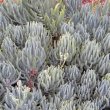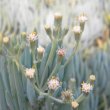| Botanical Name |
|
| Family |
Asteraceae - The daisy family. |
| Pronunciation |
sen-NEESH-shee-oh tah-lye-NOI-deez |
| Common Name(s) |
English: Thin blue chalk sticks
|
| Plant Group |
- Ground Cover A plant with a low-growing, spreading habit, grown specifically to cover the ground.
- Succulent A plant having fleshy stems or leaves often adapted to dry conditions.
|
| Plant Size |
- Small to Medium
| Tree | 8m to 15m |
| Shrub | 75cm to 1m |
| Perennial/ground cover | 20cm to 40cm |
| Bulb | 30cm to 40cm |
| Succulent | 20cm to 40cm |
|
| Position |
- Sun The area is in full sun for all or most of the day, all year round.
|
| General Information |
- Drought Tolerance: High The plant is well adapted to arid conditions; it can survive long periods of drought and high temperatures without extra water.
- Evergreen Plants that have leaves all year round.
- Frost: Half-hardy The plant is able to survive low temperatures and some frost but requires protection against severe frost.
- Water Wise Plant species originating from low rainfall regions that require less water to survive and thrive than other plant species.
- Wind Tolerant Plants able to withstand the effect of strong winds.
|
| Specific Information |
Senecio talinoides is a fast-growing medium sized succulent shrublet, with grey-blue leaves. Grown as a foliage plant which adds useful colour and form.
|
| Ad Break |
|
| Flowers |
| Description |
heads of small paintbrush-like clusters of tiny flowers
|
| Season |
- Winter to Summer Plants will seldom bloom for the entire season as given in the list, but should flower during a period within these parameters.
|
| Colour |
|
| Growth Rate |
- Fast Specifying growth rate can be very misleading as there is considerable variation of growth rate depending on type and species of plant, available water, supplementary feeding, mulching and general care, as well as the plants suitability and adaptability to the garden environment.
|
| Plant Uses |
- Accent or Focal Point A plant used to attract the attention because of its colour or form.
- Attracts bees, butterflies or other insects This plant attracts insects which can be food for birds or other creatures in your garden.
- Border A strip of ground, at the edge of a driveway or path in which ornamental plants or shrubs are planted.
- Container Trees, shrubs and ornamental species that can adapt to growing in a restricted environment.
- Edging A low growing plant that provides softness or definition to the edges of a bed or walkway.
- Filler Either a fast growing tree or shrub used temporarily to fill in an area while the permanent plants grow to a desired size, or a plant used to fill gaps in borders or beds.
- Foliage Plant Plants grown because their foliage is colorful or unique. Many of these plants have insignificant flowers.
- Ground Cover Low-lying plants that spread fast, require minimal maintenance, and cover large expanses or bare areas between bulbs or shrubs. They provide protection from erosion and drought and improve the visual appearance of the garden.
- Mass Planting Plants useful for filling a large area with just one or a few kinds of plants spaced close together. Creates a bold, dramatic effect and to reduces maintenance.
- Pioneer for new gardens A very fast growing plant, able to withstand hardship, that can be used to populate land that has recently been cleared of natural vegetation. These plants pave the way for slower-growing species by adding nutrients to the soil and creating leaf litter.
- Rock Garden An area constructed of larger rocks, arranged naturally, to emphasise the use of stones as a main element. Generally plants used do not need a lot of care.
- Stabilize Banks Plant is used to prevent soil erosion because their roots will form a mat that stabilizes the soil and keeps it from washing away in heavy rains.
- Suitable for coastal gardens Plants adapted to dry, sandy soil, forceful wind, limited rainfall and intense sunlight.
- Wild Garden An indigenous garden planted for the benefit of wildlife and birds. Provides food, water, a variety of mini-biomes and no poisonous chemicals are used.
|
| Distribution and Habitat |
|
| Planting Suggestions |
Plant in full sun in well drained soil with a little compost and a thin layer of mulch. Keep just moist until established then only when the soil is completely dry. Plant in groups.
|
| Medicinal Uses |
|
| Ad Break |
|






Comments
Your nursery?
Hello,
I happened on your site looking up Infoseek on blue chalk sticks.
I was wondering what "the collapse of your borehole" means.
Hope to visit your lovely country one day. I'm sorry to hear of your woes.
From the other side of the earth:
Victoria
Borehole collapse
Hi Victoria
Apologies for taking so long to reply.
A borehole is a deep hole drilled underground (60 meters in this case) to reach water, which is then pumped up to a holding reservoir/dam. After a heavy rain with 450 mm in four days, there must have been a great deal of water movement under the ground as our pump was immersed by silt or falling rocks, rendering it inactive. After six weeks of trying to release the pump, we had to give up and accept that our water source was no longer available. Sadly we could not afford to drill another borehole and I had to close my nursery, as this was our only source of water.
So that is my sad story - and the reason for my website being inactive for the last seven months. I simply lost heart after the loss of the nursery. However, I have finally moved on and am now backtracking 7 month's worth of comments!
Kind regards
Lorraine
Discuss this plant
Share knowledge, ask a question or give an experience.